Guineas are popular medium-sized birds that have a similar appearance to turkeys. They are also known for being noisy, yet very effective in controlling tick populations within their territory.
These stocky, round-bodied birds are native to Africa and have been raised and hunted for their meat and eggs for hundreds of years. Some people called them guinea fowls, guinea hens, pet speckled hens, or original fowl but they all are exactly the same.
Guineas belong in the Numididae family with different varieties that come in different colors from the result of several crossbreeding efforts.
There are many benefits of raising guineas as backyard birds or even to replace other domestic birds such as chickens or ducks.
Aside from meat and eggs, guineas are excellent watchdogs.
They are able to protect your property and alert you to danger. Guineas can also control the number of pests in your backyard and farm. Simply put, they are excellent natural pest controllers.
If you’re thinking of raising these birds domestically, then look no further. This article will explore the in-depth procedure, do’s and don’ts, and everything that you should know about raising guineas.
Guinea Breeds to Choose From
After the domestication of guinea fowls hundreds of years ago, these odd-looking birds have been crossbred to produce several different color and pattern variations.
Today, there are six different species that have been recognized by researchers and conservationists.
Out of these six breeds, only three of them are being raised domestically throughout the world: the helmeted guinea fowls, crested guinea fowls, and vulturine guinea fowls. No matter which breed you choose, always pick the one that can thrive and grow healthily in your specific region.

1. Helmeted guinea fowl (Numida meleagris)
Helmeted guinea fowls are one of the most common and popular guinea breeds in the United States. These birds generally stand between 21 and 23 inches tall and can be recognized by their small heads, large bodies, slate gray plumage, and hundreds of white spots scattered all over their feathers.
They have warty facial skin and a unique bone-like casque on their forehead. This breed has been domesticated throughout many countries and can be found on many farms.
Aside from being raised for their meat and eggs, helmeted guinea fowls are natural pest controllers that can eat large quantities of ticks at once.
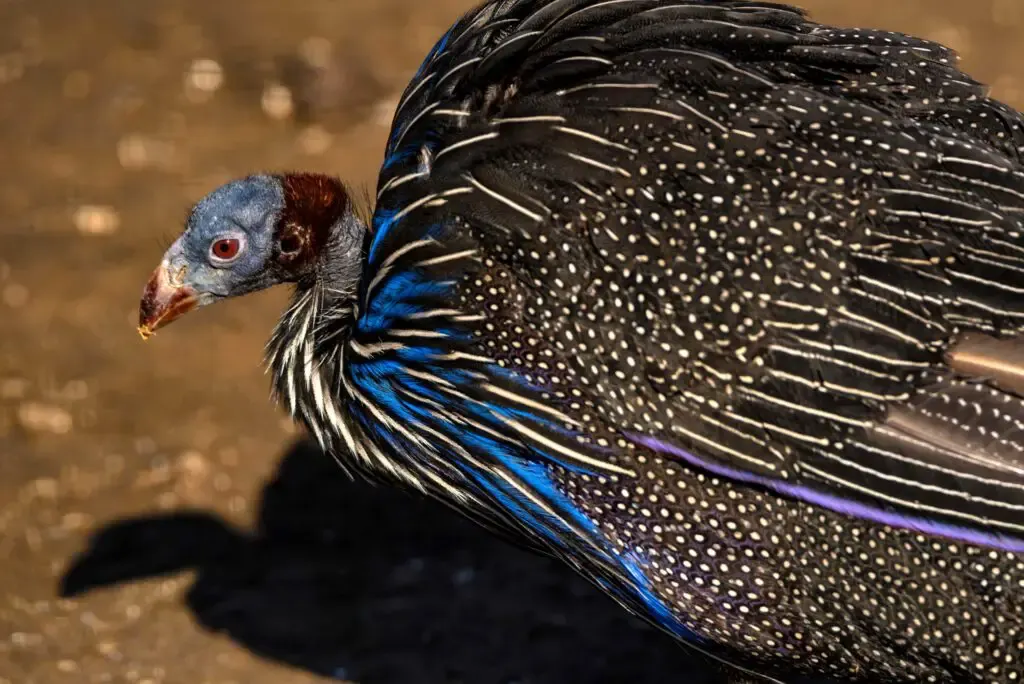
2. Vulturine guinea fowl (Acryllium vulturinum)
Being the largest breed of guineas, vulturine guinea fowls grow up to 28 inches tall with a weight of around 3.63 pounds. These long-necked birds possess stocky bodies with blue breasts, chestnut patches on the nape, and long black and white feathers that extend down to their long tails.
Vulturine guinea fowls will roost on trees at night. Although they can fly, they always run away to avoid predators and dangerous situations.
Due to their territorial nature, male guineas from this species can be very aggressive with other males. They have the same agitated and rattling call sounds similar to the Helmeted guinea fowls but slightly higher-pitched.
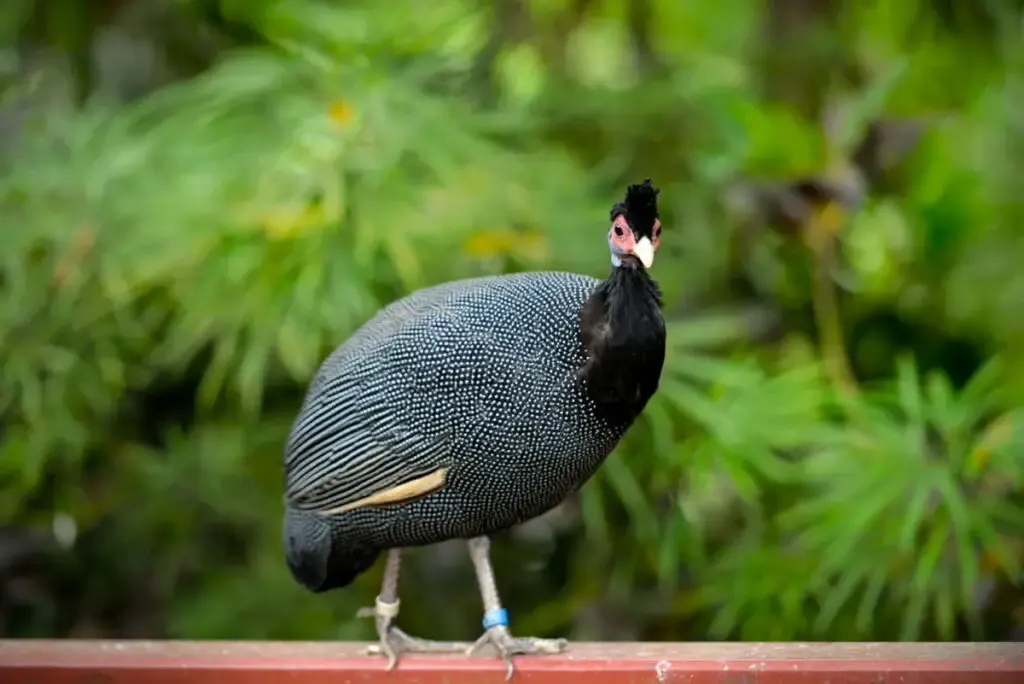
3. Crested guinea fowl (Guttera pucherani)
Crested guinea fowls can be distinguished by their unique and fancy curly crest on their forehead. These birds generally stand between 18 and 20 inches tall with a weight of around 4 pounds. They can be recognized by their small heads, round bodies, and rows of hundreds of bluish-white spots on their feathers.
They have red eyes, a mop-like black crest on top of the head, ivory-colored bills, and facial skin that comes in three different colors such as blue, red, and black.
Crested guinea fowls are curious and sociable in nature. They can mix well with other birds and are usually found in a flock of 20 birds.
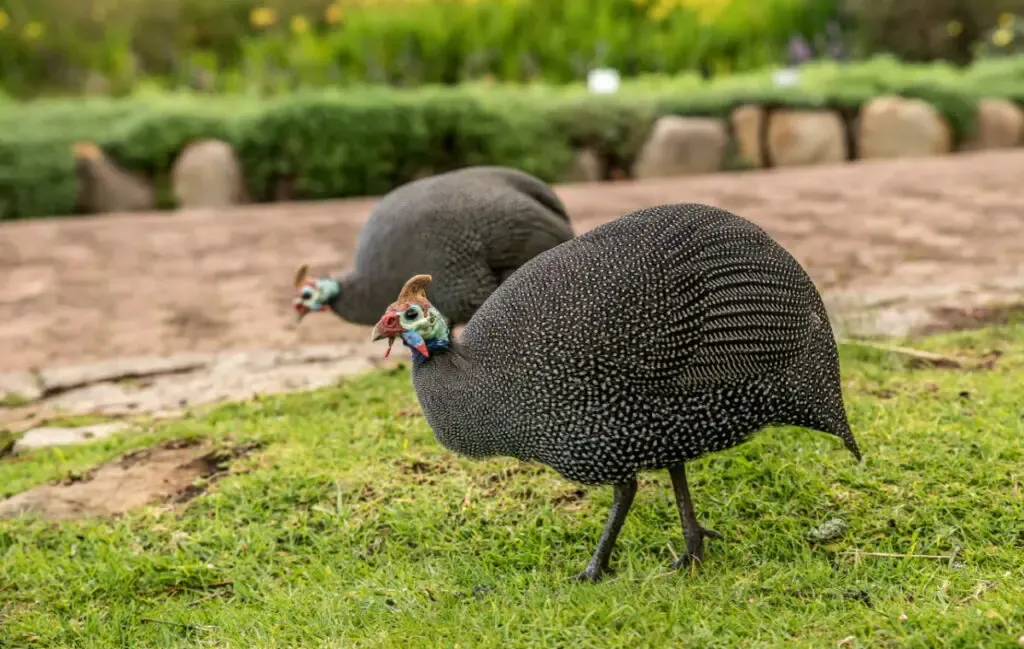
4. Plumed guinea fowl (Guttera plumifera)
Plumed guinea fowls are shy, large black guineas that inhabit humid and tropical lowland forests. These birds grow up to 17 inches tall and can be recognized by the ornate white spots on their feathers.
They have a featherless dark face with a plume of black feathers on top of the head and long wattles on the side of the bill. From time to time, they live in the same habitat as black guinea fowls.
5. White-breasted guinea fowl (Agelastes meleagrides)
These guineas are native to the regions such as the forests of Guinea, Côte d’Ivoire, Ghana, Sierra Leone, and Liberia. White-breasted guinea fowls grow up to 17 inches tall and live in groups of 15 to 24 birds.
They have red heads, small black bodies, and a white ruff around their neck. The pattern on their neck alone makes them easily distinguishable from other breeds.
These birds also have distinctive calls that sound similar to the call of a dove.
6. Black guinea fowl (Agelastes niger)
Black guinea fowls can be found in several regions in West Central Africa such as Angola, Nigeria, Cameroon, the Republic of Congo, Equatorial Guinea, and the Democratic Republic of the Congo. These birds inhabit lowland rainforests and spend their time mostly on thick forest floors.
Black guinea fowls generally stand around 17 inches tall and weigh around 25 ounces. They can be recognized by their small bodies, black plumages, long tails, and bare red heads. They also have pale speckled markings on their lower bodies.
These small, shy birds usually produce a monotonous, high-pitched “kwee” call repeated at a rate of two to three notes per second.
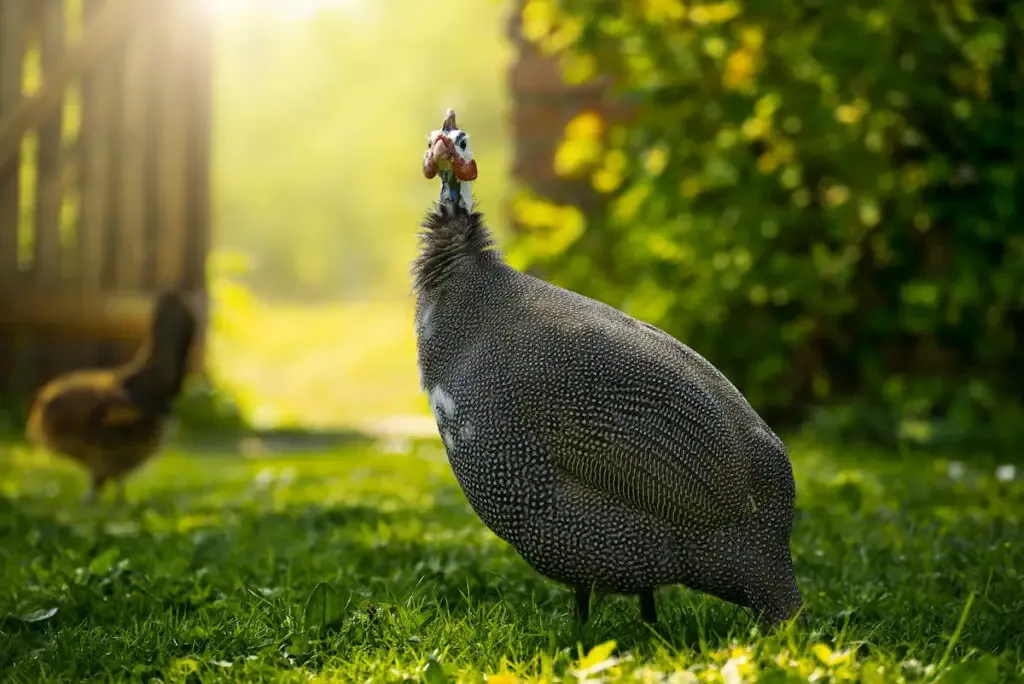
How To Feed Your Guineas
Guineas are omnivorous birds and they feed on various things. Although these birds are considered as low-maintenance animals, what they eat in the wild is different than what they need when you raised them domestically. Knowing their dietary requirement is important to ensure that they can grow without any serious health issues.
Most domesticated guineas come from the wild helmeted guinea fowls that are native to Africa. Out in the wild, these birds forage for different foods ranging from worms, snails, small reptiles, seeds, wild berries, insects, arachnids, to slugs, and other leafy plants.
But when you keep them in your farm or backyard, their diet changes to the environment that they live in and the amount of energy they need throughout the day. Adult guineas and keets also need different types of nutrients for their bodies.
Baby guineas, or keets, need special feed during their early growth phase. They require a high amount of protein, usually around 23% to 25% more than the normal feed.
When they reach five to eight weeks old, the protein ration should be reduced to 18% or 20%. After eight weeks, young guineas can be fed with a 16% mash layer or a higher protein feed with a laying-hen mash.
Only mash and crumbles can be fed to your guineas. Unlike other poultry birds, they can’t feed on pelleted food. You can also feed baby guineas with turkey starters that are available at any feed mills and local farm stores. But be sure not to purchase the ones that are medicated or specially formulated for other birds.
On the other hand, adult guineas are able to forage for themselves and look for all the food that they need.
But if you still think that monitoring what they eat is the best step to maintain their health, you can feed them with chicken feed or other poultry feed that contains 16% protein.
Most commercially processed feed is made from both plants and animal-sourced ingredients. They usually contain protein, calcium, carbohydrate, and other beneficial nutrients.
To increase their appetite and make their diet tastier, you can feed guineas with special feed. These include mixed feeds, mealworms, sunflower seeds, and wild bird seeds. In fact, some mixed feeds contain nutritious ingredients such as millet and rolled oats that guineas can’t get just by foraging alone.
If you raise guineas to free-range, they will also eat plants and foliage that act as their source of fiber, vitamins, and minerals. You can also add fruits into the mix as long as you slice or chop the fruits into tiny pieces.
Finally, don’t forget to provide your guineas with grit and a constant supply of clean water. Grit and oyster shells are some of the supplemental diets that can be fed to guineas to facilitate better digestion.
Clean water will keep these birds hydrated and help them to wash down all the feed that they eat. Don’t forget to regularly change their water and clean both feeders and waterers to avoid contamination that can affect your guineas’ health.
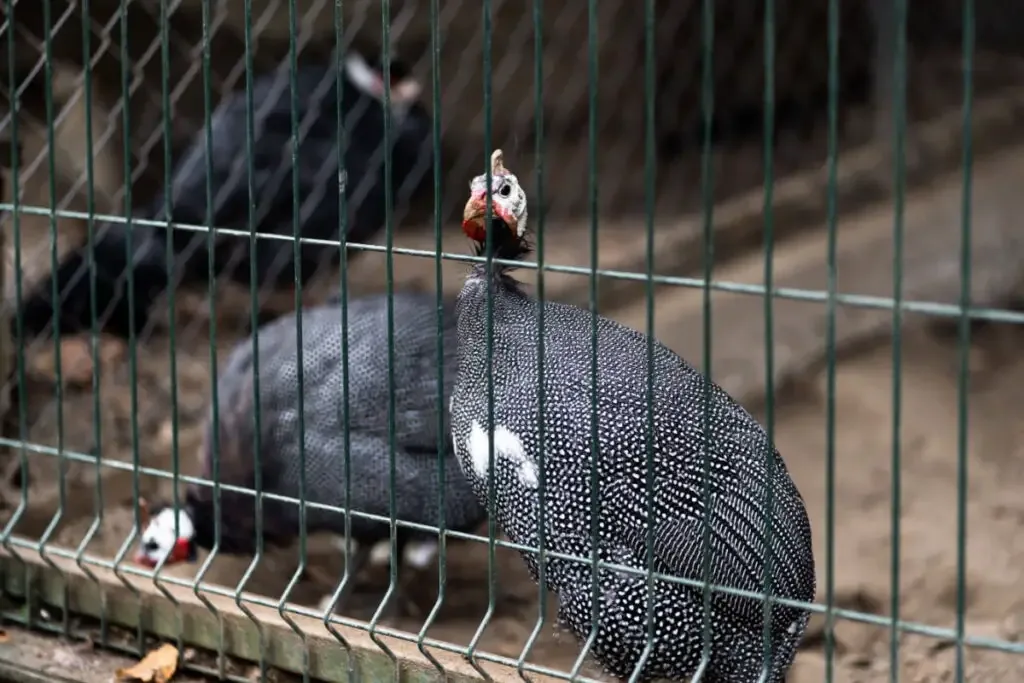
Housing For Guineas
Sheltering guineas is fairly simple. They don’t need fancy housing other than basic structures to protect them from the elements and predators. Guineas’ housing can be anything like an old barn, a large coop, converted trailer, or even a shed.
If you’re not living in a tropical or mild climate, then it is always better to have a shelter that is protected on all four sides. When cold seasons pass, you can leave the shelter’s door open during the day to allow for better air circulation.
The ideal size that is suitable for a guinea coop is around 3 to 4 square feet for each bird and a floor space between 36 square feet and 48 square feet. There is no harm in having some wiggle room to prevent overcrowding and stress issues in case your guineas grow larger before you can transfer them into another confinement.
When planning for the coop size, be sure to take into account any space that will be used for nesting boxes, shelving, feeders, and waterers.
When planning for the interior of the coop, you will also have to cover the floor with hay or straw. Aside from acting as insulators, these materials can prevent guineas from slipping and falling when they run or walk. If the hay gets wet or damp, replace it with fresh as soon as possible to avoid mold build-up that harms the guineas’ respiratory system in the long run.
Don’t forget to build roost bars or perching areas for these birds. You can use small tree branches or 2-inch by 2-inch wood that stands around 4 feet tall.
Roost bars will help guineas to fluff their feathers for a better flow of air, especially during hot and cold seasons. This is the only way that they can regulate their body temperature in relation to the changes in the surrounding temperature.
Last but not least, keep their feeders and waterers inside their shelter. This is to avoid any contamination or exposure to sunlight or rain that could spoil their feed.
You will need to train your guineas to return to their coop at night to avoid these birds from wandering too far, roosting randomly in trees, or worse, getting killed by predators when they are lost.
Guineas are pack animals and they rarely wander off or venture into the wild without their flock. So, all you have to do is introduce your guineas into the outside world or your property one by one, rather than letting the whole flock out at once. Then, put them back inside their coop when evening comes.
Repeat this process until the bird is familiar with the way they should spend their time during the day. Then, apply the same training to the rest of the flock.
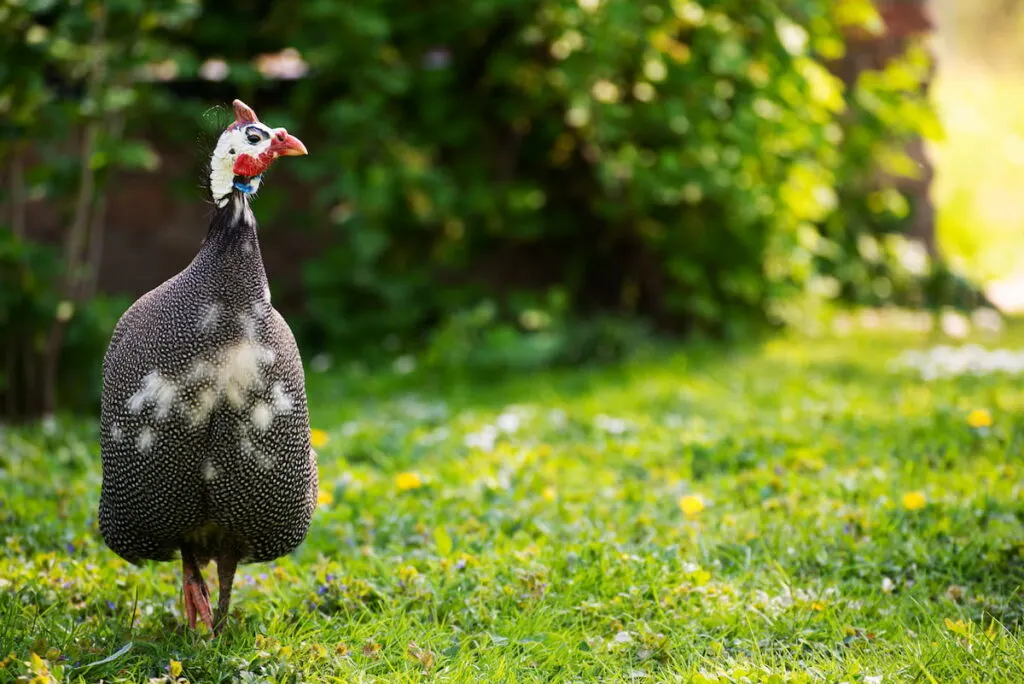
Brooding, Rearing, and Hatching Your Own Baby Guineas
When it comes to breeding your own guineas, you should always know how to tell males from females. Generally, it is quite hard to distinguish between young males and females until they are fully mature. The earliest age that the keets start to produce a call is when they reach 10 weeks old.
But there are two ways to identify the sexes from one another. First, you can listen to the sound and noises that they make. The hen can make two-syllable noise that sounds like “buck-wheat”, “put-rock”, or “qua-track” that male guineas can’t.
Then, you can also look at the size of the helmet and wattles. Males’ helmets and wattles are generally larger than females.
Guineas are seasonal layers and they usually lay a single egg per day between March or April and September or October when they reach between 26 and 28 weeks old.
But when you raise them in a flock, guinea hens will become communal layers and they will lay eggs dozens of eggs in one nest. Guineas aren’t choosy when it comes to their nest. In fact, they will take turns sitting on the nest until they reach the end of their brooding period.
One guinea hen can lay around 100 pale brown eggs that are speckled and hard-shelled. Guinea hens will continue laying the same amount of eggs until they reach five years old.
When breeding season comes, pairs of guineas will get together and search for the best nesting site. One male guinea generally can mate with four to five hens. But when you keep them in a closed shelter, they can mate around six to eight hens.
Guinea hens typically lay eggs in the late morning or early afternoon. Then, they will incubate the eggs for 26 to 28 days.
If you don’t enough hens, you can also use broody chickens to hatch guinea eggs. Depending on the size of the hens, the larger they are, the more eggs that they can sit on. Guinea hens generally don’t go broody until the nest is filled with at least 30 eggs.
Alternatively, if you think that the hens in your flock aren’t good mothers, you can put the eggs in an incubator for the same duration.
Health Issues in Guineas
Although guineas are adaptable to various climate and environmental changes, this doesn’t eliminate the fact that they are prone to suffer from certain diseases. Before we look into illnesses that can affect guineas, let’s look at how we can detect whether these birds are sick or the irregularities in their behavior are just false alarms.
- Your guineas suddenly don’t eat or drink as they used to, leading to a drastic weight loss.
- They don’t mingle with other guineas and look tired. Your guineas might also be hunched up or fluffed up even when the environment isn’t cold.
- Mucous discharge comes out of their eyes and nostrils, swelling on their faces, helmet, and wattles. These symptoms point out to a serious condition known as a swollen head syndrome.
- Your guineas can’t breathe properly. In fact, their breathing might sound rattly or tired.
- Their vent or bottom doesn’t look normal and healthy. These include redness or swelling, soiled feathers around the vent, and open sores.
- Unhealthy guineas will also have difficulties standing or walking properly. Their legs can look pale, inflamed, and swollen.

Here are some diseases that can happen in guineas:
Avian flu
Avian flu is a highly infectious viral diseases that can cause a decrease in egg production, loss of appetite, blood-tinged discharge from nostrils, and worse, sudden death.
Coccidiosis
This disease is caused by parasitic protozoa named Eimeria and they invade the cells of guineas’ intestines.
Preventive measures can be taken by administering anticoccidial drugs or feeding baby guineas with medicated feed that is produced to combat this disease.
E-coli
E-coli generally affect baby guineas (young keets) of about 8 to 12 weeks of age. Poor hygiene and litter management are some of the major causes of the spread of this disease.
Egg binding
Egg binding happens when guineas are having a hard time laying or passing their eggs. Some of the obvious signs of egg-bound guineas are panting, lameness, loss of appetite, spending too much time in their nest, shaky wing, and tail pumping. Their vent will also look wet and messy.
Fowl Cholera
Fowl cholera is highly contagious and caused by a bacteria named Pasteurella multocida. Some of the symptoms of this bacterial disease are swollen wattles, lameness, torticollis, and pneumonia.
Fowl Pox
Fowl pox can spread by mosquitoes or direct contact between infected and susceptible guineas. Scabs from infected birds might also contain viruses that can act as a source of infection. These viruses can enter the guineas’ systems through the eyes, respiratory tract, and open wounds.
Impacted crop
Impacted crop happens when guinea’s stomach becomes filled with food or mass that they can’t digest, leading to bowel obstruction. This problem can be solved by simply incorporating grit and stones into guineas’ diet.
Infectious Coryza
There are two types of coryza: simple and infectious. Simple coryza can be treated like a common cold but infectious coryza can be severe depending on the resistance and immune system of the birds.
This disease also affects chickens, pheasants, turkeys, and other game birds.
Marek’s disease
Also known as fowl paralysis, this disease is highly contagious and caused by a herpes virus. Marek’s disease can result in tumor production and sudden death in guineas.
The development of tumors can be prevented through vaccination but it doesn’t necessarily stop the virus from spreading.
Mycoplasma Galliseptum
This disease is caused by bacteria with the same name. This infection can cause chronic respiratory disease in guineas and other poultry birds.
Newcastle disease
Newcastle disease is an infection that affects most domestic poultry and bird species. This disease is categorized into three types: mild, moderate, and highly pathogenic.
Symptoms of Newcastle disease in guineas include facial swelling, hoarse chirps in chicks, twisting of the neck, lameness, panting, watery discharge from nostrils, and paralysis.
Final Thoughts
To conclude everything, raising guineas comes with many benefits that you can’t get from normal poultry birds.
Of course, there will be challenges that you have to face from time to time. But those setbacks are similar to raising other animals and they are totally manageable.
Aside from their loud calls, guineas are definitely all-purpose birds that can be raised sustainably without causing any serious trouble.
Sources:
- https://petkeen.com/types-of-guinea-fowl/
- https://morningchores.com/guinea-fowl/
- https://www.wikihow.com/Raise-Guinea-Fowl
- https://www.motherearthnews.com/homesteading-and-livestock/raising-guinea-fowl-zmaz92aszshe
- https://www.hobbyfarms.com/getting-guineas-train-them-right/
- https://poultry.extension.org/articles/poultry-management/raising-guinea-fowl-in-small-and-backyard-flocks/
- https://thegardenmagazine.com/how-to-raise-guinea-fowl-in-your-backyard/
- https://www.knowyourchickens.com/guinea-fowl/
- https://cluckin.net/diseases-of-guinea-fowl.html#mcetoc_1fb9r5d462
